We kindly inform you that, as long as the subject affiliation of our 300.000+ articles is in progress, you might get unsufficient or no results on your third level or second level search. In this case, please broaden your search criteria.
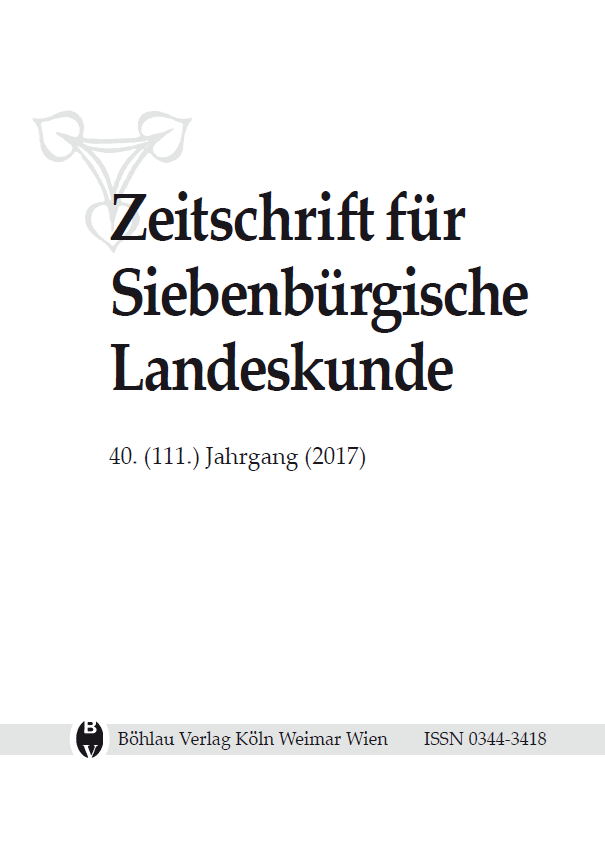
Als Kaiser Karl V. im Januar 1530 zum Augsburger Reichstag einlud, vertraute er darauf, dass die Angst vor der zivilisatorisch vernichtenden Gewalt der Türken die unterschiedlichen Religionsparteien zusammenschweißen würde. Sein freundlicher Ton, in welchem er die beiden Seiten bat, ihre „opinion und meinung“ darzulegen, verband sich mit der Hoffnung, der Reichstag möge eine Unterstützung der Türkenkriege beschließen. Das Szenario, das dahinter stand, ist offenkundig: Mit der Schlacht von Mohács am 29. August 1526 waren die Türken in das Herz Europas vorgedrungen – und sie bedrohten von hier aus nicht allein die habsburgischen Gebiete, sondern auch Sachsen.
More...
Den protestantischen Predigerbriefen, die in den ersten Jahrzehnten von Ungarns osmanischer Eroberung entstanden, widmete die Forschung seit langem eine große Aufmerksamkeit, aber ohne einen Konsens in der Frage ihrer historischen Auslegung zu finden1. Zwischen 1541-1560 trafen nämlich zahlreiche mündliche Nachrichten, Briefe, Sendschreiben aus dem besetzten Gebiet in europäischen Zentren der Reformation ein, um über die raschen Erfolge einer protestantischen Mission zu berichten. Diese Texte gelangten früher oder später in den Druck, daher konnten sie nicht nur erhalten werden, sondern sie fanden auch den Weg in die dicken Kompilationen des 18. Jahrhunderts, auf denen die moderne positivistische Geschichtsschreibung fußte. So hat sich zu Anfang des 20. Jahrhundert die opinio communis herausgebildet, dass sich die osmanischen Eroberer in die konfessionellen Streitigkeiten zu Gunsten der Protestanten (und vor allem deren helvetische Richtung unterstützend) aktiv einmischten. Im Großen und Ganzen fasst diese Meinung Jenő Zoványis Reformationsgeschichte zusammen.
More...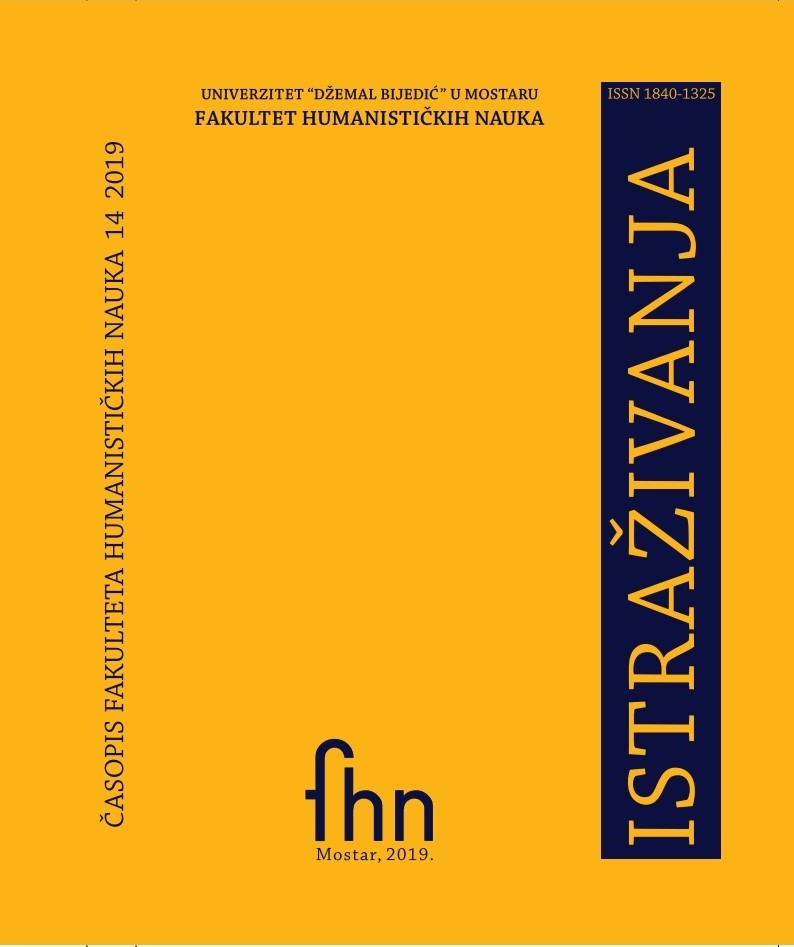
Abdulvehab İlhami, who lived between 1773-1821, is one of the greatest representatives of Alhamiyado literature. In addition to the poems he wrote in Bosnian, he is regarded as one of the important intellectuals of the period and the works he received in Turkish and Arabic. At the same time, İlhami, known for his mystical identity, is considered one of the prominent mysticos in public. The period when İlhami lived was a time when the Ottoman State and Bosnia Herzegovina faced many problems in political, military and economic terms. İlhami expressed his deficiencies in the poetry with the irritating and uncomfortable manner of the deficiencies that occurred during his period. In addition to his poetry and mystical personality, he was engraved into the cultural memory of the Bosnian people who were executed by Bosnian governor Celal Pasha. The remaining parts of the dark about the cause of the execution were filled in by the Bosniaks in their own imitations, and they came with a number of menus describing the execution of Ilhami. In fact, the famous satyr that he wrote for Celal Pasha was shown as the reason for this execution. The first and only historical document giving information related to the execution of Ilhami, the governor of Bosnia Celal Pasha, who was sent to Istanbul in 1821, and the reason for the incarceration of part of the execution of some of the soldiers who acted with him, related to the reasons for the killing of Ilhami.
More...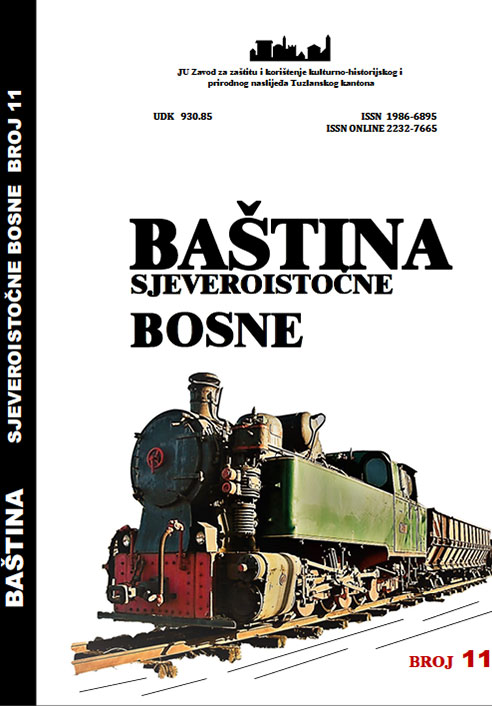
Turija has been mentioned under this name since the Middle Ages and throughout the Ottoman period, which testifies to the historical continuity of organized living in this settlement. It was a part of the parish and then Ottoman organizational unit Dramesin. The paper provides an overview of the houses and inhabitants of Turija according to the 1850 census, and an overview of the results of the 1879, 1885 and 1895 censuses. The old mosque in Turija was built in the second half of the 19th century, and in this paper the authors present the results of field research of tombstones in the harem of this mosque.
More...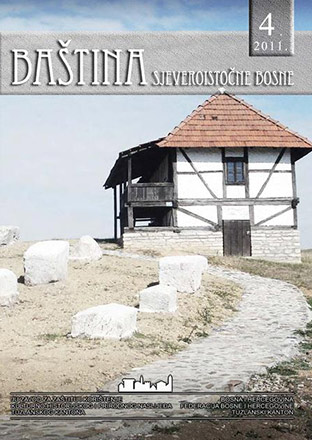
Kod nas je teško reći koliko treba neka familija provesti vremena u nekom mjestu ili kraju pa da kažemo da je to stara familija ili da pripada starinačkom stanovništvu. Najčešće je to od 500 godina (kraj srednjeg vijeka) pa do 100 godina (austrougarski period). Za grad Tuzlu se može sa sigurnošću kazati da još krajem osmanskog perioda ima više stotina različitih prezimena, pa i familija. Pa bi se moglo usvojiti da starinačko stanovništvo Tuzle je ono koje tu živi od osmanskog perioda, odnosno stare tuzlanske familije su one koje tu kontinuirano žive najmanje 150 godina (od sredine 19. stoljeća). Mada se i porodice koje su doselile u Tuzlu po dolasku austrougarske uprave, u Tuzli ponekad smatraju starim (ali za sve njih se dobro zna odakle su doselile i kojih starih familija u tim mjestima su ogranci).
More...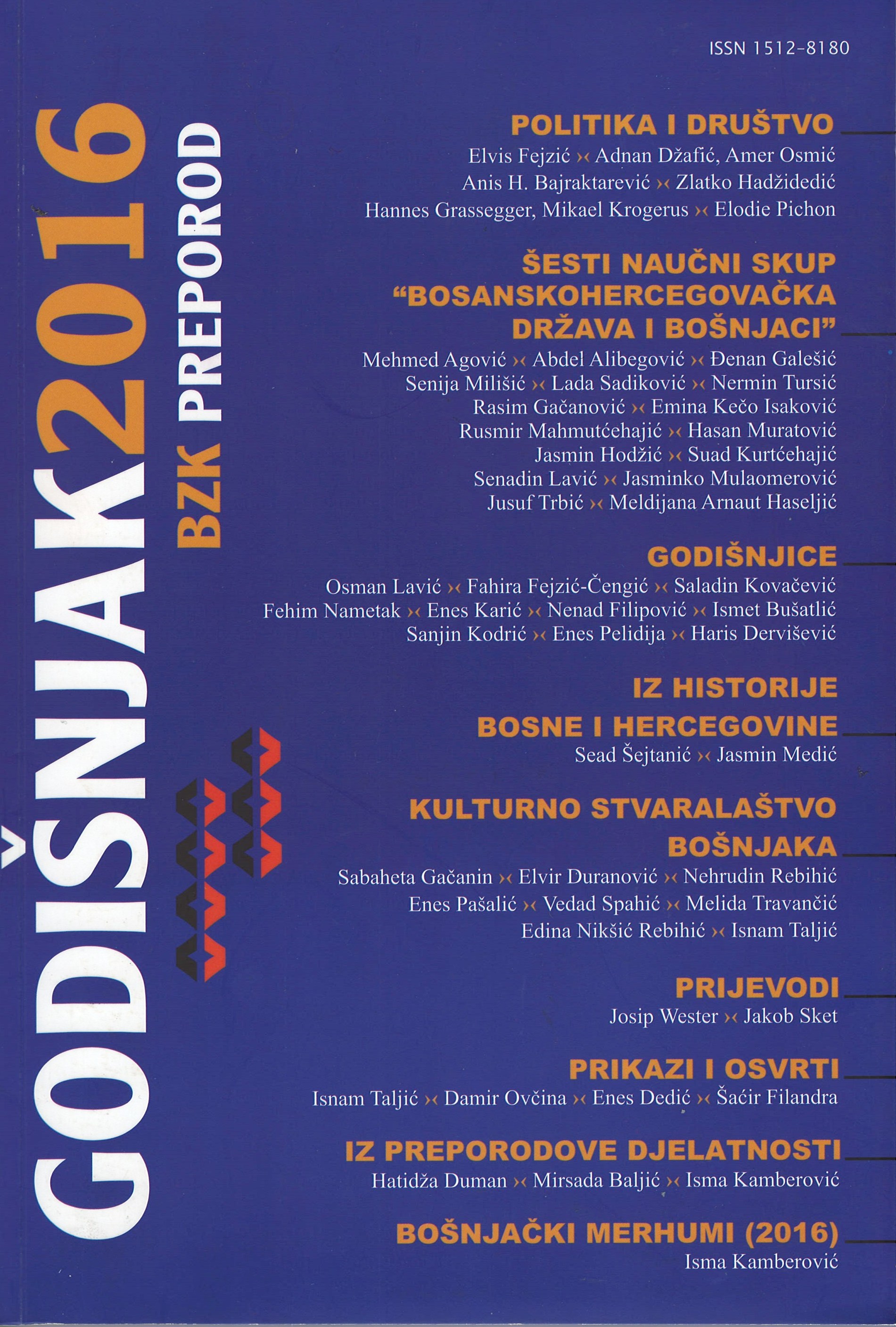
In 2016 marks 100 years of the birth of two great scholars: Hazim Šabanović and Adem Handžić. Both of them were Ottoman scholar-historians and Orientalists as well as Islamic jurists-high graduates of Islamic Sharia-theological school (VIST). The institution known as VIST has given not only numerous of Islamic jurists-and-theologians, but numerous of graduates who have gained great reputation in ex-Yugoslavia as well as scholars from the humanities, museum professionals, archivists, bibliographers, librarians, administrative officials, judges, lawyers, even doctors and engineers. This indicates the high quality of not only Islamic, but also the general, education that could be acquired in that institution. Both Šabanović and Handžić were born in 1916 - the first in Poriječani near Visoko, and other in Tešanj. They both finished Gazi Husrev-bey High School (1935) and VIST (1940). Both were briefly worked as judge-trainees (1940-42). For a long time, they were colleagues - employees at the Oriental Institute in Sarajevo. They both made a huge contribution to the world Ottoman scholarship and better knowledge of Ottoman Bosnia and the Ottoman Balkans. In many other aspects their spiritual biographies were different so it is the best to write separately about the importance of their contribution. This article will first deal with Šabanović, then Handžić.
More...
This paper is an attempt to give a short overview of the political situation in Herzegovina sandžak during the last years of Ottoman rule in Bosnia. During that period, Ottoman rule was more or less in constant hostility and conflict with the non-Muslim subjects in the southeast part of Herzegovina sandžak. All these riots were premeditated tactic of Ottoman state enemies and attempt to expand at its expense
More...
Torlak Alija was one of the most popular heros of the Ottoman period. During his life, a lot of songs were registered about his strength, courage and bravery, and after his death, his grave became a cult place for Muslims. In this paper, based on the available sources, we will try to partially illuminate this great hero's life and folklore of Muslims Torlakovac and Vince about it.
More...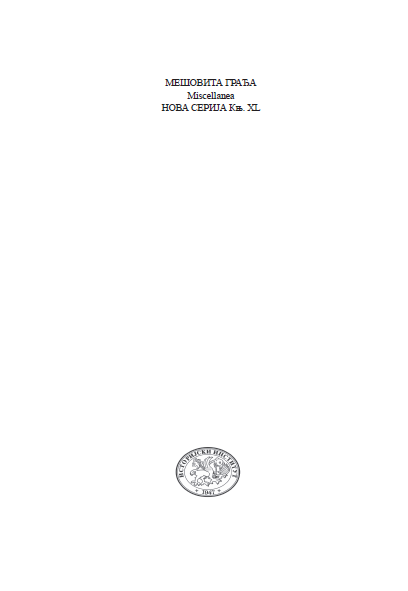
This paper presents one example of Venetian contracts for beef trade through the port of Zadar, during the period between 1784 and 1785. All of the contracts were printed in identical form, and are preserved in the number of fifty five. The names of merchants from Sarajevo, dates of conclusion of contracts and dates of transaction were inserted in additional fields. The paper also presents the names of these merchants from Sarajevo, with data on every transaction that they arranged for beef trade. Special attention is paid to the merchant with the surname Socivizza, a family from Sarajevo that was famous for cattle trade. One merchant from this family died in Venice ten years after he concluded the type of contract presented here. The contracts are preserved in the State Archives of Venice, and they are important for understanding trade between Venice and Ottoman Bosnia.
More...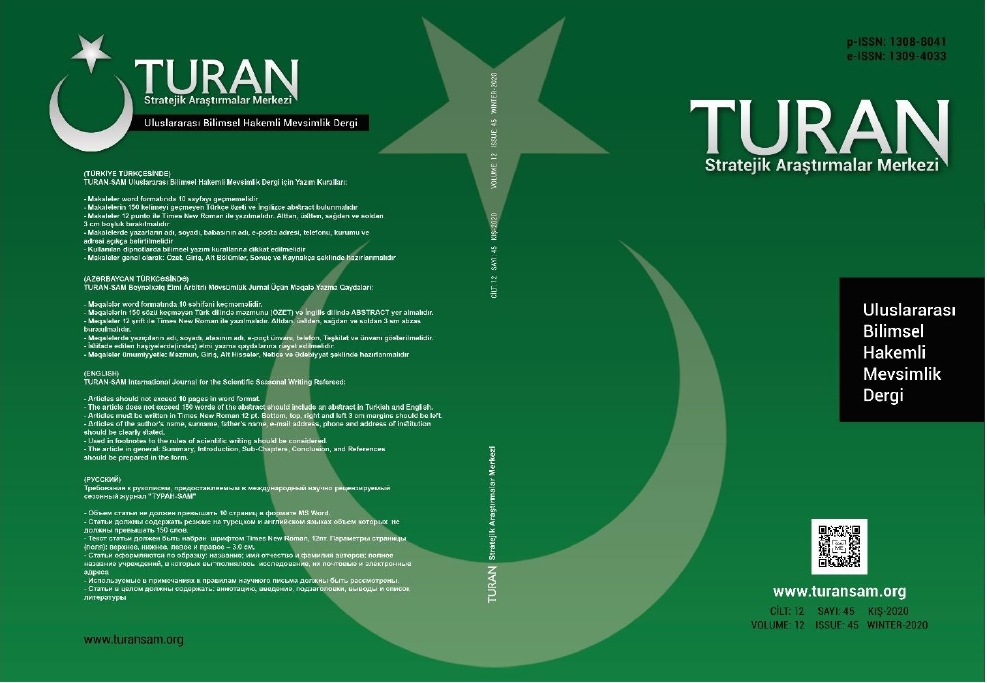
When the historical process is analyzed, the Turks followed a progress and development from east to west. One of the most important periods in this process belonged to the Seljuk period. The Seljuks, a true state after the success gained with the Dandanakan war, continued their existence in a very large geography. They have achieved serious successes in the fields of government administration, organizing, raising the state and scientists. They constituted a significant foundation for the Ottoman State and in many respects made indirect contributions to the structure that has survived to the present day. Depending on the developments over the years, it maintained its important position in history for justified reasons. One of the sources of these justifications has been the subject of environment, which today's societies deal with great sensitivity and importance. The multidimensional environmental sensitivity that Seljuks exhibit in their understanding of life is one of the important reasons for their deep traces in history. In this regard, it was tried to highlight the important sensitivities of the Seljuks on the environment by considering them. The environmental sensitivity they show in accordance with their superior civilization understanding is undoubtedly one of the most important reasons for this situation and has been the main target of the study.
More...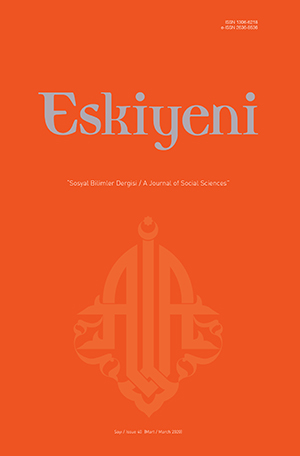
The modernization concept that started in the last period of the Ottoman Empire was seen as a compulsory way to follow after the foundation of the Republic. Founded in 1923, CHP is the party that ruled the country alone between 1925-1945. Since one party was in the administration it is named as the “One-Party Period” between those years. Between the years 1925 and 1945 content of the modernization was seen in many fields such as political, socio-cultural, economics as being completely Europeanized, which was also reflected in the publications launched in the one-party period. One of the types of publications in which this understanding of modernization is seen as the most obvious is the works for etiquette (ādāb al-muāsharah). From the point of the quantity of these works, it is seen that the etiquette books published in the one-party period are relatively more than the Ottoman period. While 18 works were published in the late Ottoman period, 26 books were published in the one-party years. Within the scope of this research, 26 books with the title including the phrase “ādāb al-muāsharah” were examined. It was understood that the aut-hors fully supported the socio-cultural changes that the political administration of the period wanted to make. Considering that these books were published at a time when religious and moral education was problematic; it is understood that it plays a clear mission and vision role in gui-ding the perception of the value of the society. There are differences in the use of the language of religion in publications before and after 1930. The language of religion which was seen as a mean of legitimizing the innovations brought by one-party management in the pre-1930s publications seems to have been used deliberatetly in the secular expressions, and the religious element, expression and way of living were belittled. In this article, firstly, the conceptual framework was explained and then the publications for the subject were examined in terms of changing the perception of value under the titles of personal, family, social and institutional etiquette. Altho-ugh it was realized with modernization and European influence, it is seen that this issue had been important since the times of Sultan Mehmet the Conqueror and taught as a lesson in schools. Similar courses were included in the late Ottoman education and training curriculum. Looking at the publications launched in the one-party period in terms of authors, it is seen that some of compiled more than one work. In the publications, it was emphasized that personal care means modernization and that both men and women should mind. Otherwise, it is stated that it won’t be valueable. This situation is valid not only for men but also for women. Another set of rules that men and women must follow is the way they conduct in social life. The reason why it is compul-sory to follow these behaviors arises from the thought of ensuring the survival of the state. Ot-herwise, the common understanding was that the state will be shaken. For the reason that the only way the newly established state has chosen for itself is modernization. The survival of the state is mentioned in these works, which will be possible through the daily application of the European tradition. Looking at the works, it is seen that the understanding of family has changed quite a lot. It was stated that the way family members address each other changes and some concepts are not suitable for use. It is no longer inconvenient to enter the houses with shoes, but various types of entertainment such as New Year’s Eve enters into family life. A particular issue mentioned about the family is the understanding of gender equality. It was stated that the old ti-mes/administrations did not provide equality between men and women. The main issue that is expressed primarily for corporate prosperity is respect for managers. The second duty of a citizen who minds corporate success is to work hard and pay taxes. It is often mentioned that the future of the state depends on it. In some of the publications, it is seen that French, German, and Italian manners were taken as guides. While the French influence prevailed in the last period of the Ottoman Empire but at the beginning of the one-party years, it is understood from the publicati-ons that after 1930 the British rules of life gradually gained worth. In the publications, women and girls are mentioned as the most important social segment that must obey the rules. For this reason, it has been tried to express the values through women’s, which are considered in the books of the etiquette. The types of clothing such as veils and burqa are expressed as out of age, and the types of clothing related to women’s issues such as clothing-dressing and eating-drinking are mentioned. According to the published books of this period, it is quite natural for women to drink alcohol and dance with men. Even the woman should have a good knowledge of these. This indicates that the perception of value has changed and / or is desired to be changed. Many etiquette books were published after the one-party period. When these books are examined in general, it can be seen that they are parallel to the political understanding of the period. While publications of the last period of the Ottoman Empire is a signature of modernization from vari-ous perspectives, it is a way of becoming European in every aspect in the one-party period and making sense of value and direction. In fact, while the concept of “ādāb al-muāsharah” was an expression of modernization before 1945, this situation started to lose its importance in the following years and became a conservative expression especially after 2000. As a result, we can express this: Many of the personal, domestic, social and institutional issues mentioned in the etiquette books published in the one-party period are important in terms of being a sign of the changing value perception of the period. In every period, there have been various types of publi-cations which justify the innovations that political will wants to realize. In the single-party pe-riod, it is possible to see the etiquette books as a type of publication expressing the innovations that the constitutive will want to realize. Since the socio-cultural innovations realized by the constitutive will between 1925 and 1945 were directly or indirectly related to religious insights and practices, the works that were published in this period presented a new perception of value to the society.
More...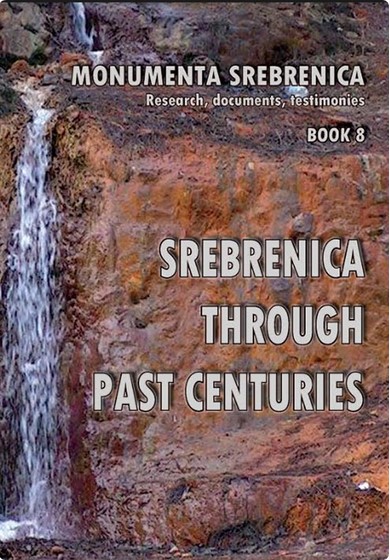
Authors wrote earlier about Hamza Dede and his tekye, that he erected in 1519 in the village Orlovići, not far from the old castle Kušlat (on the road Vlasenica-Zvornik). Even S. Bašagić touched upon this in his works, and then others also referred to it (M. Karanović, R. Muderizović). Dr Muhamed Hadžijahić particularly dealt with that question. Based on four preserved Ottoman documents on the tekye (berats) and based on some other modest data, Hadžijahić tired to enlighten the formation of the tekye and its significance. He put special effort in the determination of the development and work of the Dervish Order, that is the Order of Hamzevije in Bosnia, that should – according to its name, and based on some other circumstances – originate from that tekye and which due its heretic teaching, and as it seems, also due to active participation of some followers in certain rebels against the Ottoman Empire, in the second half of the 16th century, was severely persecuted.
More...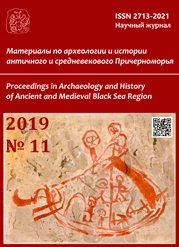
The Dniester archaeological expedition conducted research of the lower tier of the South-East tower of the citadel of Bendery fortress in February—March 2019. The stone crumb floor with lime was cleared at a depth of 3.35 m from the entrance level. Its building is connected with the first stratigraphic horizon of the tower (1538). The second horizon is represented by filling the lower tier of the tower in the form of a light yellow loess like loam with a thickness of 1,6—1,7 m, in which fragments of pottery ceramics of the 16th century, metal items and animal bones were found. Archaeological research in 2019 confirmed the version that the first stone fortifications were built here by the Turks, and not earlier than the end of the 1530s. It was established in the course of the excavation that the second stratigraphic horizon was formed during the reconstruction and expansion of the fortress in 1584. The Moldavian ruler Peter Hromoi began reconstruction of the fortificationsб which were dilapidated during Polish-Cossack raids, at the beginning of this year, on the orders of the Turkish Sultan. The inner ditch and the Lower Fortress were built within a few months. Loam from the filling of the ditch was used to fill the lower tier of the South-East, and probably other citadel towers, to strengthen them against the intensified siege artillery and tunnels. The materials of this horizon reflected new trends in fortification art of the second half of the 16th century in the North Black Sea region and neighboring regions.
More...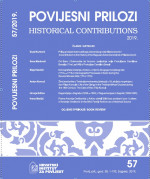
This paper presents the life of the Catholic clergy in the Trebinje-Mrkan diocese during the 18th century on the example of Rev. Filip Kuncul (1726-1771), who fled the diocese to the Republic of Dubrovnik in fear of Turkish persecution. As he refused to return to his office, he had to defend his case before his bishop. His example reveals two features of life in the area of the Trebinje-Mrkan diocese during this period. Owing to its position at the frontier between the Ottoman Empire, the Republic of Dubrovnik, and the Venetian Republic, this diocese was characterized by a high emigration rate, as the population often fled to the Republic of Dubrovnik for various political, economic, social, and religious reasons. At the same time, the bishops of Trebinje-Mrkan, settled in Dubrovnik, lamented the lack of priests throughout the 18th century as one of the diocese’s gravest ailments, actively seeking to secure a sufficient number of priests to serve there. These features are well exemplified by Rev. Filip’s life. Due to his parents’ poverty, he was sent to serve in Dubrovnik as a boy. The then bishop of Trebinje-Mrkan, Sigismund Tudisi (1692-1760), contacted him at that time, persuaded him to receive the priestly orders, and then sent him to serve in his native parish of Gradac. However, his service at the parish was short-lived, only four years, because he incurred the wrath of the Ottoman authorities by helping in the transfer of a pregnant woman to the Republic of Dubrovnik and was forced to flee there himself. Due to his leaving the parish and his refusal to return to his post, Rev. Filip had to defend himself before Bishop Tudisi, who threatened him with ex-communication. Finally, Rev. Filip sought and received protection in Rome from the Congregation for the Doctrine of the Faith, and never returned to active service in the Trebinje diocese.
More...
After the collapse of the Ottoman Empire, the traditional waqf law has gone through a reform. Republican reforms abolished the Islamic waqfs and replaced them with "foundations", an institution adapted from the Swiss Civil Code as it was regarded practically more eligible to reshape the former system. Turkish Republic introduced a new civil code in 1926. Under this new code, the waqf institution was changed into an organization detached from its Islamic background. The present essay is going to examine the waqf reform carried out in modern Turkey. The kind of the waqf prescribed by the code of 1926 and the waqfs existed during the Ottoman times were entirely different institutions. The predominant aspect of the newly introduced waqf is evident in its new status which is detached from its religious background. It was actually created and appropriated by considering the similar European organizations. Under the new law waqf is realized as a legal entity. The Islamic perpetuity principle has a rather different meaning under the Turkish Civil code. In this respect, this article will not only consider the legal aspects of waqf law but also it will consider the historical circumstances that paved the way to reshaping the former waqf system in the Republican era.
More...
For many countries in Europe, both in the West and in the East, the nineteenth century was critical in their respective paths towards the attainment of national independence goals. Each nation had its own unique struggles in that political course. Albania, and the Albanian nation was no exception. The seizure of the Albanian territory by the Montenegro, Serbia and Greece during the last two centuries severely affected the Albanian nation. The aim of this research, however, is not to focus exclusively on the ways and means related to Albanian territory division, but to delve into foundations of the selected events, with great impact to the Albanian nation. The current developments and challenges in the Albanian territories in the Balkans cannot be productively analyzed without examining the historical context, within which, the Prizren League played a critical part. Indeed, even though the League, at the time, was largely overlooked by the Western powers, still played, an important role in the ensuing Albanian historical developments. The League, initially an Ottoman supporting mechanism, of mutual (AlbanianOttoman) interest, developed into an autonomous organization revolting to the perceived enemies of the Albanian cause, later, even against the Ottomans. This study aims to highlight the causes of the formation of the Prizren League, its activities, Albanian revolts against the perceived enemies and other related topics that painted their ordinary life, in the stipulated period. The objective of the research is to focus exclusively on the Western sources visa-a-vis the examined topics in an endeavor, to present, as much as possible, an unbiased picture of events and developments. Numerous themes have been explored in light of many old and authentic sources, in an attempt to enrich the quantity of the examined themes with qualitative inputs. The study also delves briefly on the Western powers’ interest in ‘solving’ the Albanian question in rather idiosyncratic way. Finally, the study concludes that the Prizren League establishment and their respective commitment, determination and cohesion, not only played a critical role at the time, but even today still serves as an inspiration, to the younger generation of Albanians, across the Balkans and beyond.
More...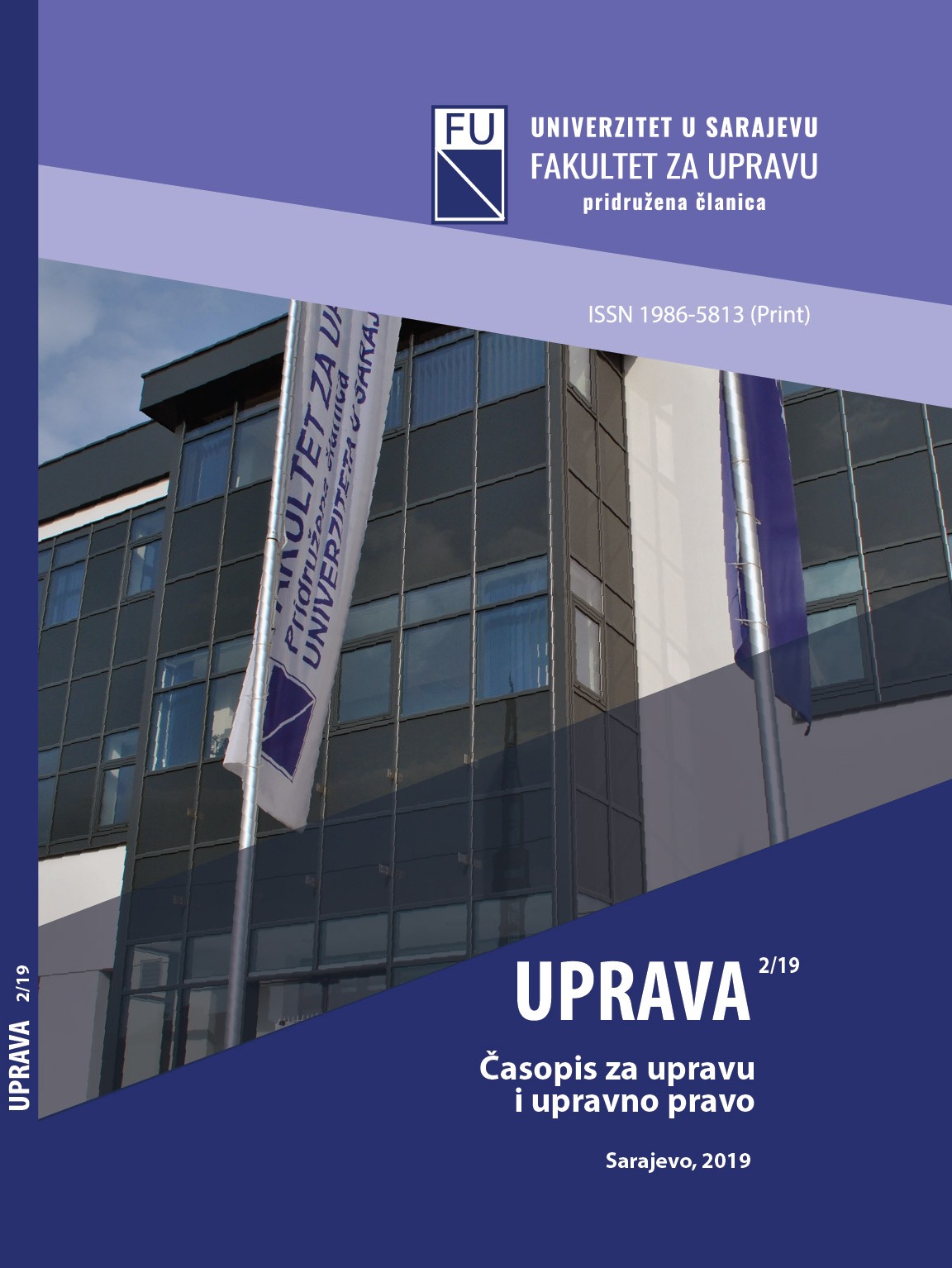
The paper presents the administrative status and administrative organization of Kadiluk Šabac (Bögürdelen) during the Ottoman Empire. The introductory part gives a brief overview of the administrative-territorial organization of Sandžak Zvornik, which comprised the territory of Kadiluka Šabac, and then presented the administrative organization of Kadiluk Šabac throughout its existence from 1521. until the end of the Ottoman rule in this region.
More...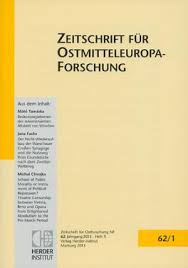
Review of: Das Bild des Feindes. Konstruktion von Antagonismen und Kulturtransfer im Zeitalter der Türkenkriege. Ostmitteleuropa, Italien und Osmanisches Reich. Hrsg. von Eckhard Leuschner und Thomas Wünsch. Mann. Berlin 2013. 512 S., zahlr. Ill. ISBN 978-3- 7861-2684-3. (€ 79,–.). Reviewed by Bogusław Dybaś.
More...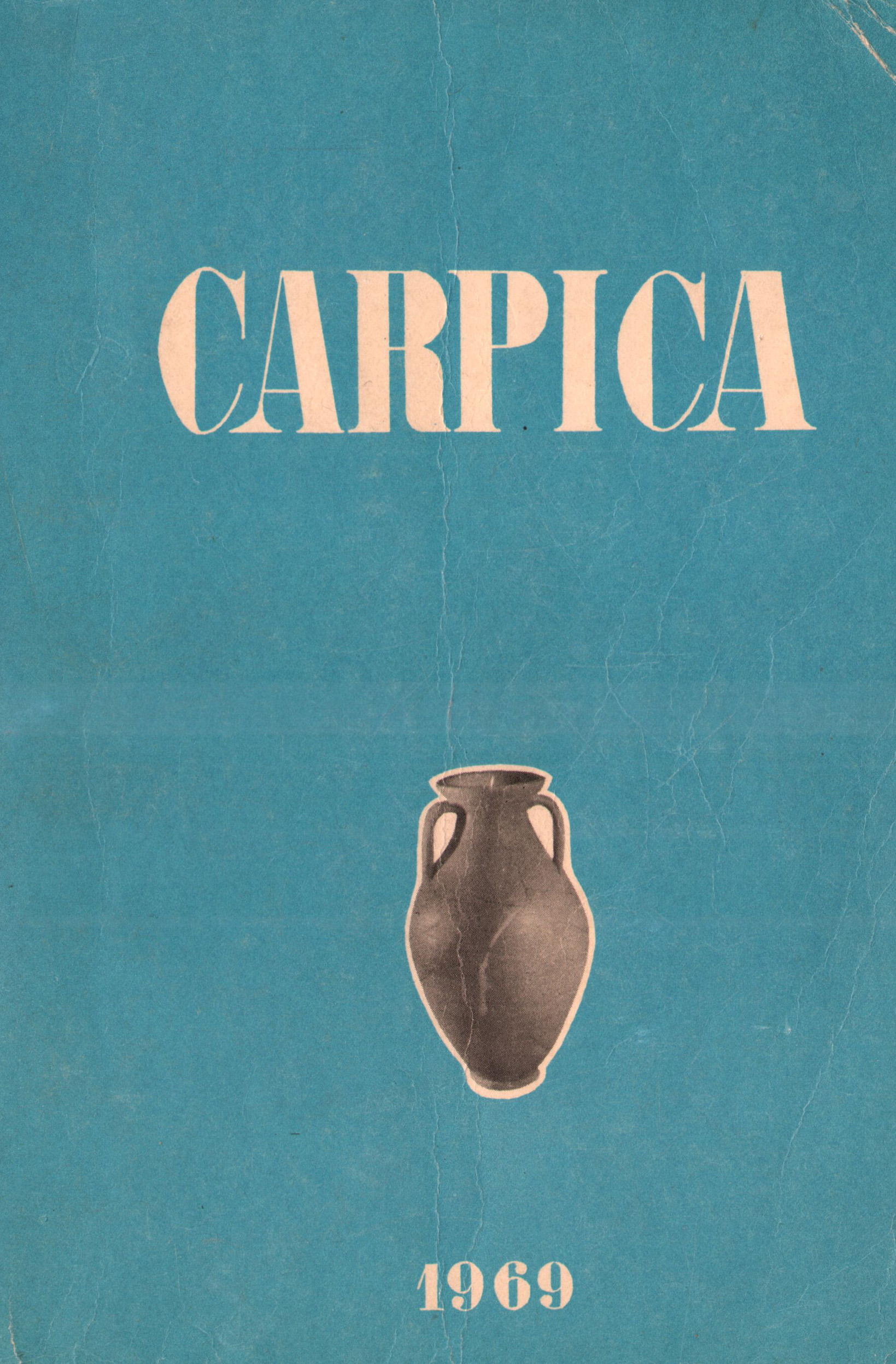
Articolul prezintă un tezaur de monede otomane (sec. al XVIII-lea) descoperit la Copăcești (jud. Vrancea).
More...